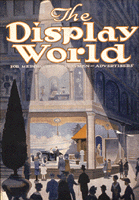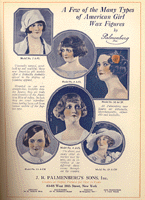You're a professional—you know the retail score these days. Wal-Mart is the world's largest retailer, Sears has recovered from what appeared to be imminent doom, and you can't swing a cat without hitting some sort of themed-restaurant-with-mandatory-T-shirt-shop. (No cats were harmed during the writing of this article.)
But as George Santayana might have said (if he had been a comic and not a philosopher), “Those who forget the past are condemned to repeat history class.” Yes, we need to know where we've been to get a clearer view of where we are. Fortunately for you, we're in the memory business, and like any good griot, we're perfectly happy to take you for a little cruise down Memory Lane. Our particular journey begins in a time when Sears was only a catalog and Stanley Marcus was a teenaged store clerk in Dallas. . .
1922: The Display World commences publication in Cincinnati. Its competition includes the Merchant's Record and Show Window, which began in 1897 and which was edited at one point by former Macy's displayman L. Frank Baum, who would go on to write the Oz books. This is also the year Macy's goes public.
1923: Barney Pressman founds Barneys New York on 17th Street in Manhattan. May Department Stores Co. (which includes Famous-Barr), St. Louis, acquires A. Hamburger and Sons in California.
1924: Macy's holds its first Thanksgiving Day Parade. Dubbed the “Christmas Parade” and covering a five-mile route from Harlem to Herald Square, the parade consists primarily of Macy's workers and immigrants who missed the festivals common in Europe.
Advertisement
1925: The first Sears retail store opens in Chicago, taking the catalog retailer into a new era.
Mid-1920s: More durable, heat-resistant “mannikins” begin to supplant wax figures commonly used in display.
1926: The first Montgomery Ward retail store opens in Plymouth, Ind., as another catalog merchant follows the lead of Sears.
1927: The Neiman-Marcus catalog debuts. Although relatively tame for its first 30 years, “The Book” will eventually become a symbol of conspicuous consumption. May acquires Bernheim-Leader, Baltimore.
1929: The presidents of Abraham & Straus, Brooklyn; Bloomingdale's, New York City; Filene's, Boston; and F. & R. Lazarus, Columbus, Ohio, go for a cruise off Long Island and agree to form the holding company known as Federated Department Stores. Formica, invented as an electrical insulating material, becomes popular in the display industry. In the suburbs of Kansas City, Mo., the first suburban shopping center, called Country Club Plaza, opens, anchored by Kresge's. The J.C. Penney Co. offers stock on the New York Stock Exchange in October. The market crashes shortly thereafter—no connection is found.


 Photo Gallery3 days ago
Photo Gallery3 days ago
 Headlines1 week ago
Headlines1 week ago
 Sector Spotlight2 weeks ago
Sector Spotlight2 weeks ago
 Headlines1 week ago
Headlines1 week ago
 Headlines4 days ago
Headlines4 days ago
 Headlines2 weeks ago
Headlines2 weeks ago
 Designer Dozen1 week ago
Designer Dozen1 week ago
 Headlines2 days ago
Headlines2 days ago
















